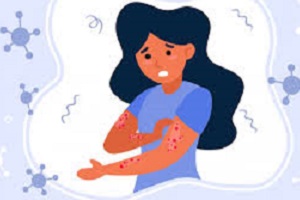By Setareh Kiumarsi
What is Psoriasis?
Psoriasis is an autoimmune skin disease.
In autoimmune diseases, the immune system becomes overactive. This overactivity leads to inflammation in various parts of the body, and in the affected organ, the immune system mistakenly starts attacking the body’s own cells.
In psoriasis, a type of autoimmune disease, white blood cells (T lymphocytes or T-cells) mistakenly attack the skin cells. This faulty attack causes skin cells to multiply rapidly, accumulate on top of each other, and form inflamed, raised patches with white scales on different parts of the body like the scalp, elbows, or knees.
How to Address Psoriasis at its Root
For a fundamental treatment of psoriasis, it’s essential to change your diet and lifestyle. In the previous ten posts, the autoimmune diet has been covered in detail. (If you haven’t had a chance to read them, you can click the links to check them out.)
Topics include:
- What are autoimmune diseases and conventional treatments?
- The effect of nutrition on autoimmune diseases
- The link between gluten and autoimmune conditions
- Foods containing gluten
- Common ingredients in gluten-free products
- Gluten-free products available in Iran
- The impact of dairy on autoimmune diseases
- The effects of sugar, animal protein, and legumes
What Can You Do to Soothe Your Skin Topically?
- Avoid direct sunlight exposure on the affected areas.
- Mix the following herbal powders in these ratios:
- Turmeric (3 parts)
- Neem (1 part)
- Myrtle (or chickpea or oat flour) (1 part)
- Mallow or psyllium (1 part)
- Colorless henna (1 part)
- Application: Once or twice a day, mix 1 teaspoon of the blend with a little warm water to form a soft paste. Apply it to affected areas for 15–20 minutes, then rinse off. Afterwards, moisturize using:
- Fresh aloe vera gel
- Cucumber slices
- Raw potato slices
You can find aloe vera leaves in most herbal shops. A single leaf can last a month in the fridge.
On days when you’re home, cut off a small piece, scoop out the gel into a small bowl, and apply it to the affected skin every 30 minutes.
It hydrates, relieves itching and inflammation, and helps regenerate skin cells.
Remedy for Severe Dryness in Psoriasis
- Blend the following in a mixer:
- 1 raw cucumber
- 1 raw potato
- 2 tablespoons fresh aloe vera gel
- 1 teaspoon rosewater
- Store the paste in the fridge. Apply to dry, affected areas once or twice a day for 15–20 minutes.
- You can also use castor oil or myrtle oil to moisturize damaged skin.
Healing Smoothie for Flare-Ups
During intense flare-ups, have the following vegetable smoothie for breakfast or as a snack:
Blend together:
- 1 carrot
- 1 handful spinach
- 1 handful cilantro
- 1 handful parsley
- 1 glass warm water
- ½ tsp turmeric
- ¼ tsp rose powder
- 1–2 tsp lemon juice
- 2–3 tsp honey
- A pinch of salt
Eat 1–2 bowls of cooked apple or pear daily:
Chop the fruit, steam it with cardamom and rose petals, and add a bit of honey once cooled.
Lunch Plate Tip: Make sure 20–30% of your lunch includes one or more of the following fully-cooked and spiced vegetables (with turmeric, saffron, fennel, or coriander seed): Cilantro, Celery, White cabbage, Cauliflower, Broccoli, Mung bean sprouts
Drink the following three times daily during severe outbreaks:
Blend and strain:
- 1 handful fresh coriander
- ⅓ glass warm water
- ½ tsp fennel powder
- 1 tsp honey
Drink milk thistle tea once or twice a day, or consume ¼ cup milk thistle extract three times daily.
Follow the skin detox plan once a month to keep your skin happy.
These days, we unfortunately hear more and more people around us—friends, family—being diagnosed with autoimmune diseases like lupus, rheumatoid arthritis, MS, psoriasis, celiac, inflammatory bowel disease (IBD), Hashimoto’s, type 1 diabetes, Addison’s disease, and so on. Each of these names sounds like a frightening monster, and when someone is affected, it casts a shadow over their life.
What happens in these diseases?
The immune system becomes overactive. This excessive activity leads to inflammation in various parts of the body; and in the affected organ, the immune system mistakenly begins to attack the body’s own cells.
For example, in psoriasis, white blood cells or T lymphocytes mistakenly attack skin cells. This faulty attack causes skin cells to multiply rapidly, accumulate, and create raised, inflamed patches of skin with white scales, on areas like the scalp, elbows, or knees.
But what does traditional medicine say about autoimmune diseases?
In traditional medicine, the balance or imbalance of the digestive system plays a key role in a person’s physical and mental health. In fact, many physical and psychological illnesses are rooted in poor digestion and toxin buildup in the gastrointestinal tract.
From the perspective of traditional medicine, individuals suffering from autoimmune diseases (like lupus, rheumatoid arthritis, MS, psoriasis, celiac, IBD, Hashimoto’s, etc.) typically have a weak digestive system. Imagine the digestive tract as a pot with a fire burning underneath. Well, for these people, the fire under that pot is very small and weak. This weakness means the digestive system cannot properly and fully digest certain foods (which are often heavy, phlegmatic, and hard to digest).
Incomplete digestion of these foods leads to the formation of toxins in the digestive tract. These toxins then circulate through the bloodstream and lymphatic system and accumulate around cells that are already weak; whether due to genetics or previous illnesses.
The body’s response to get rid of these toxins is to activate the immune system. Essentially, the immune system tries to “burn up” the toxins through inflammation (fire). But usually, the toxins are too abundant and stubborn to be eliminated completely. So, in this fire-filled, inflamed environment, the affected organ begins to deteriorate.
So what can we do to solve this problem?
Common Treatments
We’ve now gained a basic understanding of what autoimmune diseases are and how they develop, how the immune system becomes overactive and attacks the body itself.
In modern medicine, to control autoimmune diseases (like lupus, rheumatoid arthritis, MS, psoriasis, celiac, IBD, Hashimoto’s, etc.), doctors prescribe immunosuppressants or corticosteroids. These medications are anti-inflammatory—they reduce the element of fire in the body. It’s like pouring a bucket of ice water on a burning piece of clothing.
By extinguishing the fire, these drugs suppress the immune system and quickly, effectively rescue the affected organ from immediate danger.
But as explained earlier, from the viewpoint of traditional medicine systems like Ayurveda or Iranian traditional medicine, the root of autoimmune diseases is a weak digestive fire.
Long-term use of immunosuppressants not only reduces inflammation (fire) in affected organs, but also weakens digestive fire. It’s like pouring a glass of cold water over your digestive flame; putting it out and slowing metabolism. That’s why many people gain weight or develop swelling after taking corticosteroids.
In other words, these medications are effective in managing and reducing the symptoms of autoimmune diseases, but over the long term, they weaken the digestive fire even more, fail to address the root cause, and often lead to chronic worsening of the disease.
Now imagine you’ve been diagnosed with an autoimmune disease. There are a few different approaches you can take.
One approach is to adopt the “life’s too short, eat whatever you crave” mindset—letting your treatment and disease management rest entirely on the shoulders of immunosuppressive medications, while enduring their side effects for life.
Another approach is to begin a dialogue with your body. Observe it. Befriend it. Learn its language. Realize that when you feed it poorly or expose it to unhealthy environments, it protests—manifesting through worsening symptoms of the disease.
Your body is asking you, without words, to stop eating whatever you crave and start nourishing it properly. Trust that once the entry of harmful foods stops, the level of inflammation in your body will gradually decrease, the immune system will put down its weapons, and stop attacking your organs.
Choosing the second approach doesn’t mean rejecting modern medicine. But in many cases, when a patient improves their diet and lifestyle, symptoms decrease, the disease quiets down, and with their doctor’s supervision, medication doses can be reduced or even stopped.
As we discussed earlier, in autoimmune conditions the immune system is like a soldier with its sword drawn, it’s overactive, has lost its discernment, is triggered by the slightest provocation, and ends up harming the body’s own organs.
On the other hand, there are certain foods we typically consume to boost our immune system. You’ve probably heard your grandmothers say, “Eat onions when you have a cold,” or “Eat turnips,” or “Have a spicy soup to strengthen your body’s defenses against viruses and bacteria.”
But now ask yourself: for someone who’s taking a cocktail of immunosuppressive drugs daily, what effect do immune-boosting foods have?
You guessed it. It’s like handing a pile of ammunition to the already overly aggressive immune soldiers who can’t distinguish friend from foe.
So people with autoimmune diseases should be cautious when it comes to regularly consuming foods that boost the immune system:
Supplements containing zinc, medications or herbal infusions with echinacea
Eggplant, turnip, ginger, raw radish, raw daikon, garlic (raw or cooked), raw onion (cooked onion is okay), raw scallions, hot peppers, masala, shallots, mustard, curry, cayenne, black pepper, red pepper, chili, cinnamon (in large amounts), black cumin, and wild celery seed (in large amounts)
Try using milder spices in your cooking instead of strong and spicy ones that overstimulate the immune system:
Warming spices: fennel, saffron, nutmeg, turmeric, cumin, rosemary, thyme, cardamom, clove, basil, and sage
Cooling spices: coriander seed, sumac, rose petals
As a rule of thumb, for every three parts of warming spices, use one part of a cooling spice. For example, a mix of turmeric + cardamom + cumin (warming) balanced with rose petals (cooling).
What else?
Stimulants and energizers like alcohol, marijuana, energy drinks, tobacco, and most importantly caffeine—including coffee, instant coffee, black tea, green tea, chocolate, cocoa—all are considered qualitatively hot and dry.
Remember how I said in the earlier posts that when the immune system is overactive, it’s like the body has a fever? The level of inflammation and fire element in the body is already high and is burning through the organs of the affected person.
So if someone with an autoimmune condition smokes a pack of cigarettes a day, drinks a couple of beers, has two or three cups of coffee, or five or six cups of black or green tea, or eats dark chocolate, they’re just fueling that fire even more. The body doesn’t even get a chance, despite all the immunosuppressive medications, to lower the inflammation.
So, reduce your intake of these substances as much as possible. Instead of coffee or tea, try drinking one of the following from two hours after every meal, once every hour:
1 glass of warm water + a few drops of lemon + a slightly heaping teaspoon of honey + a pinch of salt (this drink isn’t salty, sour, or sweet—it’s a bit neutral)
1 glass of boiling water + a few fresh basil leaves + a few rose petals
1 glass of digestive tea or balanced herbal infusions (you can find lots of balanced tea recipes by searching on the Ananda website)
Have you ever heard the word gluten?
Lately, you might have noticed that many organic and health-conscious products are labeled “gluten-free.”
Or maybe, you’ve seen that most restaurants have a separate gluten-free menu—and people who want to live healthier often choose their meals from that menu.
So what exactly is gluten? Gluten is a combination of two proteins found in certain grains like wheat, bulgur, barley, oats, etc. It’s what gives dough its elastic and sticky texture.
Because of this, gluten-containing grains are much heavier, stickier, and harder to digest than gluten-free ones like rice or corn.
In previous posts, we learned that in people with autoimmune conditions, metabolism is slow. Imagine the digestive system as a pot with a fire underneath it—well, in these individuals, the fire is tiny and weak. Now imagine throwing a plate of pasta in that pot… or a slice of thick bread… or a cream-filled pastry. All these delicious gluten-containing foods are incredibly heavy and hard to digest—they’re like industrial-strength glue! A weak digestive fire can’t handle them. What happens then?
Incomplete digestion of these foods leads to the formation of sticky phlegm (known as mucus, or toxins) in the GI tract. This phlegm first sticks to the intestinal villi. No matter how hard the gut tries, it just can’t break them down—its efforts fail.
So what’s the body’s response to all this sticky buildup? It activates the immune system and increases inflammation in the intestines. Essentially, the immune system creates a localized fever at the site of toxic accumulation to try and burn it off. But these toxins are so stubborn and excessive that the immune system simply can’t keep up… and since the area is flooded with inflammation and heat, the intestinal walls start getting damaged.
This leads to a chronic issue known as leaky gut syndrome. This condition (which is common in people with autoimmune diseases) results in persistent inflammation throughout the body.
But there’s more. These undigested toxins and phlegm spread through the bloodstream and lymphatic system, traveling to areas of the body that are already weak—whether due to genetics or past illness. And in those vulnerable organs, the same destructive cycle repeats. The immune system attacks, thinking it’s clearing toxins, but ends up damaging the body itself.
People with celiac disease experience extreme reactions to gluten—just a trace amount can cause severe digestive distress.
But others with autoimmune diseases like lupus, rheumatoid arthritis, MS, psoriasis, IBD, Hashimoto’s, type 1 diabetes, Addison’s, etc., may not show any immediate reaction when they eat gluten. Outwardly, nothing seems to happen. But in reality, gluten silently fuels chronic, ongoing inflammation in their bodies.
When gluten is removed from the diet (along with other allergens like cow’s dairy, which I’ll discuss in upcoming posts), inflammation levels significantly drop, the immune system calms down, and symptoms begin to fade.
You might think switching to a gluten-free diet sounds difficult or overwhelming—especially since in Iran gluten-free products aren’t widely available or of great quality. But once you see how dramatically it can help quiet down autoimmune conditions, you’ll likely find yourself willingly embracing the challenge.
What are the signs of gluten intolerance or incomplete gluten digestion?
Bloating, alternating bouts of diarrhea or constipation, abdominal pain and cramping, chronic headaches, persistent fatigue, skin problems, depression, anxiety and restlessness, joint and bone pain, numbness in hands and feet, chronic skin issues, malabsorption syndrome, iron deficiency, anemia, leaky gut syndrome, and brain fog.
Who benefits from a gluten-free diet?
Two groups of people usually see significant health improvements after adopting a gluten-free diet:
1. People diagnosed with the following conditions:
Autoimmune diseases (like celiac disease, lupus, rheumatoid arthritis, MS, psoriasis, inflammatory bowel disease (IBD), Hashimoto’s, etc.), various cancers, endometriosis, irritable bowel syndrome (IBS), diabetes, chronic fatigue syndrome, obesity, polycystic ovarian syndrome (PCOS), infertility, chronic respiratory conditions (such as asthma or severe allergies), attention deficit hyperactivity disorder (ADHD), autism, chronic depression, melancholia, epilepsy, schizophrenia, bipolar disorder, memory loss, and Alzheimer’s.
(Explaining the link between gluten consumption and each of these conditions from a complementary medicine perspective is a big discussion, and unfortunately beyond the scope of this article. God willing, if I get the chance, I’ll cover these one by one in the future.)
2. People who genetically tend to retain a lot of moisture in the body (or in Ayurvedic terms, those with dominant Kapha dosha—or in traditional Iranian medicine, a phlegmatic temperament), or those suffering from a Kapha imbalance or excess internal moisture. Think of people who gain weight easily, constantly have phlegm in their throats, catch colds frequently, have a slow metabolism, hypothyroidism, high blood fat, and so on.
For the first group, especially those with autoimmune diseases, it’s best to fully commit to a gluten-free diet. For the second group, it’s recommended to minimize gluten intake as much as possible. Why? Because, as discussed in earlier posts, gluten-containing foods are sticky and heavy. Consuming them leads to increased internal moisture and phlegm in the digestive tract and body, further slowing down metabolism.
So which foods contain gluten?
Everything made with wheat and its derivatives: various breads, pasta, lasagna, pizza, noodles, cookies, cakes, biscuits, pastries, and desserts.
Anything made with barley, bulgur, couscous, and semolina.
What about oats? Oats are naturally gluten-free, but because they’re often grown or processed alongside gluten grains, they can become contaminated. Unless the packaging specifically says “gluten-free,” they may not be safe for people with severe gluten sensitivity.
Factory-made chicken, meat, and vegetable stock cubes.
Processed meats like sausages, cold cuts, and nuggets.
Vegetarian sausages and burgers (many use gluten for texture and binding).
Vegan cheeses.
Egg substitutes used in vegan cooking.
Canned legumes.
Store-bought chocolate milk.
Ketchup, mayonnaise, soy sauce, teriyaki sauce, and most restaurant sauces.
Malt and all its derivatives.
Beer and malt beverages.
Restaurant-made meatballs, schnitzels, wheat-flour porridge, potato chips, and roasted nuts.
(A more comprehensive list of gluten-containing foods can be found online.)
Which grains are gluten-free and can replace wheat for those who are sensitive?
Rice, corn flour, cornstarch, quinoa, millet, sorghum, buckwheat, amaranth, flaxseed, potato starch, tapioca, and soy flour.
If you live in the U.S., Canada, or Europe switching to a gluten-free diet isn’t that complicated. A wide variety of gluten-free products are readily available.
One important thing to pay attention to when choosing gluten-free products is the main ingredients they’re made of. These days, the most commonly used ingredients in the gluten-free food industry include: rice flour, corn flour, cornstarch, quinoa flour, millet flour, sorghum flour, buckwheat flour, amaranth flour, flaxseed flour, potato starch, tapioca starch, soy flour, almond flour, peanut flour, and coconut flour.
A lot of gluten-free products (like bread, pasta, cakes, and cookies) are made mostly with corn flour; sometimes making up 80–90% of the recipe. Corn flour is considered a light and easily digestible ingredient in Ayurvedic medicine. It’s often recommended for people with a lot of moisture in their body (dominant Kapha dosha or phlegmatic temperament), especially those who are overweight.
But unfortunately, due to the high rate of genetically modified (GMO) corn today, it has become a common allergen. What does that mean? It means consuming large amounts of corn can increase systemic inflammation and overactivate the immune system (although consuming small amounts of corn flour, especially when mixed with other flours, is generally not problematic).
Keep in mind that consuming too much corn can also cause irritation in the intestinal wall and rectum. So if you suffer from hemorrhoids, fissures, anal tears, or colitis, you should be extra cautious with corn-based products.
So try to lean more toward gluten-free products that are primarily based on rice flour, with other flours present in smaller amounts.
What about soy flour? It shares the same issue as corn—it’s often genetically modified and is a major allergen.
And what about quinoa, millet, sorghum, buckwheat, amaranth, tapioca starch, and flaxseed flour? All of these are considered light flours and, when combined with other gluten-free flours, are typically easy to digest.
How about potato flour and starch? From an Ayurvedic perspective, potatoes are extremely cold and dry in nature. When consumed in excess, they slow metabolism and cause constipation. Since people with gluten sensitivity or poor gluten digestion often already have slow metabolisms, eating gluten-free products made mostly from potato flour or starch (80–90%) can lead to digestive issues like bloating or constipation (though again, small amounts combined with other flours are usually fine).
What about nut flours—like those found in keto products?
To get just one tablespoon of peanut flour, a large quantity of peanuts needs to be ground up. So if you eat a piece of keto bread or a keto dessert made with just 2–3 tablespoons of nut flour, it’s like eating 2–3 handfuls of peanuts in one go. Did you know that nuts are extremely dense in texture and high in fat? When consumed in large amounts and in dry form, they’re very heavy and can take hours to digest.
Many people choose keto products thinking they’re healthier or easier to digest—but then they feel bloated and heavy afterward.
Among all the nut flours, almond flour is the lightest, while peanut flour is the heaviest. (In general, remember that peanuts and cashews are not recommended for people with autoimmune diseases.) It’s best to use nut flours in combination with other gluten-free flours, rather than on their own or in large amounts.
The content in this post is based on feedback from my clients who have gluten sensitivity. Over the years, by observing improvements or flare-ups in their symptoms after consuming these products—and by investigating the ingredients used—I gradually formed the following conclusions. (Just to be clear, this post is in no way promotional. The only goal is to introduce gluten-free brands available in Iran.)
Sahar Bakery has been offering gluten-free products like sandwich bread, pastries, and cookies for a few years now. Unfortunately, the gluten-free flour blend used in their white breads is a bit on the heavy side. It seems their products contain a high percentage of potato starch, which, when mixed with rice flour, creates a dense and hard-to-digest texture. That’s why people with slow metabolism often end up experiencing constipation or heaviness in the stomach when eating these products daily. Many of my clients eventually stopped using them and looked for alternatives.
That said, Sahar has recently launched a gluten-free bread made with date seed flour (what they call “brown gluten-free toast”), which is much lighter and easier to digest. I’ve heard lots of positive feedback from clients about it.
Kalleh has also started producing gluten-free items under the brand name Selino. Their breads are made only with potato starch—no rice flour, corn flour, or other additions. Because of that, their breads are lighter than Sahar’s white gluten-free bread. However, if you’re prone to constipation or suffer from frequent joint pain, these breads might not be ideal for you either, since potato (especially in large amounts) is not beneficial for such conditions.
What about rice cakes?
During the production of rice cakes, the grains are deep-fried—so each rice puff absorbs oil. This makes them slightly heavy for those with very slow metabolisms. Still, they’re far easier to digest than gluten-containing products.
What else?
There’s a great online store called Tanagholat (www.tanagholat.com / @tanagholat.shop), which offers a wide variety of healthy snacks—many of which are gluten-free and sugar-free. Just be mindful of the ingredient lists, and remember what I explained in the previous post about the quality and digestibility of different gluten-free flours. Try to choose products low in sugar and those with a higher ratio of rice flour compared to other types.
And what about healthy protein bars from brands like Mani or Keta Rich?
These protein bars are usually a mix of nuts, dried fruits, and light grains like corn or oats. They’re considered healthy snacks. Just be careful with the ones that are packed with peanuts. Peanuts are lovable, yes—but they’re also sticky, hard to digest, and can significantly raise inflammation levels in people with autoimmune conditions.
As we’ve mentioned before, people with autoimmune conditions often have slow metabolism. If we imagine the digestive system as a pot on a flame, the flame beneath that pot is quite small and weak in these individuals. Cow’s dairy, in terms of quality, is very damp, heavy, sticky, and hard to digest. A weak digestive fire simply isn’t strong enough to break it down. What happens then?
Incomplete digestion of dairy leads to the formation of sticky phlegmatic residues (also called mucus or toxins) in the digestive tract, and the same scenario occurs as with gluten: inflammation, buildup, and stress on the immune system. (If you haven’t read the earlier posts about gluten, make sure to check them out.)
Also, because the immune system in these individuals is already hyperactive, it doesn’t respond well to a protein called casein, which is found in cow’s dairy. The moment it senses casein, it overreacts, like drawing swords, and creates inflammation in the body.
When cow’s dairy is eliminated (along with other allergens like gluten), the body’s inflammation levels noticeably decrease, the immune system settles down, and the symptoms of the disease start to ease.
What about dairy from other animals?
Sheep’s milk? No—it’s also high in casein, very heavy, and hard to digest.
Goat’s milk? It’s lighter than cow’s dairy, easier to digest, and generally tolerated better by people with autoimmune conditions.
Camel’s milk? It’s very light, easy to digest, and considered one of the safest dairy options for those with autoimmune diseases.
Donkey’s milk and horse’s milk (if you have access to them) are even easier to digest than camel’s milk.
Anything else to note?
Be aware that sour or fermented dairy products (such as cheese, yogurt, sour cream, and whey) create much more inflammation than plain milk in people with autoimmune conditions. No type of cheese is recommended; not even goat cheese.
Sugar
Sugar is synonymous with undigestible phlegm. It is very sticky and heavy. Like gluten, sugar fills the digestive tract with moisture that is bad and indigestible, disrupting the immune system. During your treatment period, avoid sugar and sugar-containing products (such as chocolate, pastries, desserts, ice cream, jam, etc.) as much as possible. Note that there is no qualitative difference between white sugar and brown sugar—brown sugar is simply white sugar boiled with molasses.
Natural Sweeteners
Which is the heaviest and which is the lightest?
In Ayurveda, most naturally sweet foods are moist, anabolic, and can contribute to weight gain. Some sweeteners produce excessive moisture, making them heavy and sticky—suitable for those who are underweight and want to gain weight, such as date syrup, fig syrup, and grape syrup.
However, for someone with an autoimmune disease, slow metabolism, or excessive moisture or bad phlegm in the body, consuming the above syrups is not ideal.
Some natural sweeteners are lighter, produce less moisture, and are easier to digest. These are more suitable for those suffering from diseases caused by accumulation of bad phlegm in the body (such as diabetes, autoimmune diseases, high cholesterol, obesity, etc.), like maple syrup, mulberry syrup, stevia, and agave.
Did you know that two sweeteners are actually catabolic, drying, and phlegm-burning rather than moistening? In other words, instead of adding moisture and weight, they help burn fat and promote leanness. These are honey and apple syrup, the best sweeteners for individuals with excessive moisture in their bodies.
Animal Proteins
Animal proteins such as beef, veal, and pork are very heavy and hard to digest. Completely remove these from your diet.
Seafood
Contrary to common belief that seafood is very healthy, these proteins are major allergens, difficult to digest, and not recommended for individuals with autoimmune diseases. If you love fish, try to consume mostly salmon and limit seafood like fish or shrimp to no more than once every one or two weeks.
The lightest and easiest-to-digest animal proteins for people with autoimmune diseases are poultry, especially quail, partridge, and chicken breast. For red meats, goat and camel meat can be included in small amounts. Remember: eating less meat is much better—do not consume more than half the palm of your hand in a single serving and always accompany it with plenty of vegetables or a digestive-friendly salad.
Legumes and Potatoes
If autoimmune disease affects your joints or digestive tract (for example, in rheumatoid arthritis, inflammatory bowel disease, celiac disease, etc.), eliminate potatoes and legumes as much as possible. In Ayurveda, legumes and potatoes are considered very cold and dry, significantly increasing the wind element in the digestive tract and joints, worsening symptoms.
Avoid dishes based on legumes, such as lentil stew, chickpea and bean soups, meat stews, falafel, and hummus. Also, do not eat raw cold and dry vegetables like lettuce, cabbage, cauliflower, broccoli, Brussels sprouts, endive, kale, celery, and cilantro—always cook them with suitable oils (like sesame, olive, grape seed, etc.) and digestive spices (such as fennel, turmeric, cardamom, cinnamon, cumin, thyme, rosemary, etc.).
If autoimmune disease affects your skin, hair, eyes, or nervous system (such as lupus, MS, alopecia, etc.), minimize consumption of strongly sour or salty foods, including:
Cheese, yogurt, whey, dried curd, verjuice, vinegar (pickled foods), ketchup, mayonnaise, soy sauce, teriyaki, mustard, peanuts, cashews, pineapple, melon, cantaloupe, very sour fruits (like plums, green tomatoes), and salty snacks (chips, puffed snacks, pretzels, salty whey).
How to help your body feel better
Incorporate daily or weekly cleansing tools into your routine. For example:
Every two to three weeks, try a cleansing diet. Choose one from the links below and treat your body kindly for a few days:
o Four-day vegetable cleansing diet
o 1-day vegetable juice cleanse
o Cleansing diet for skin diseases
Alternatively, integrate digestive-friendly salads, teas, and lassi into your daily routine.
If you are serious about spending more time with your body and mind, learn its “language,” take better care of it, start with “where should I begin?”, take the constitution test, become familiar with your dosha, and gradually, with consistency and dedication, incorporate Ayurvedic routines step by step into your daily life.
I love and respect you all…
Stay full of health.
Please be sure to credit the author, Setareh Kiumarsi, when sharing or republishing this article, which was written with love and the hope of well-being for all.







